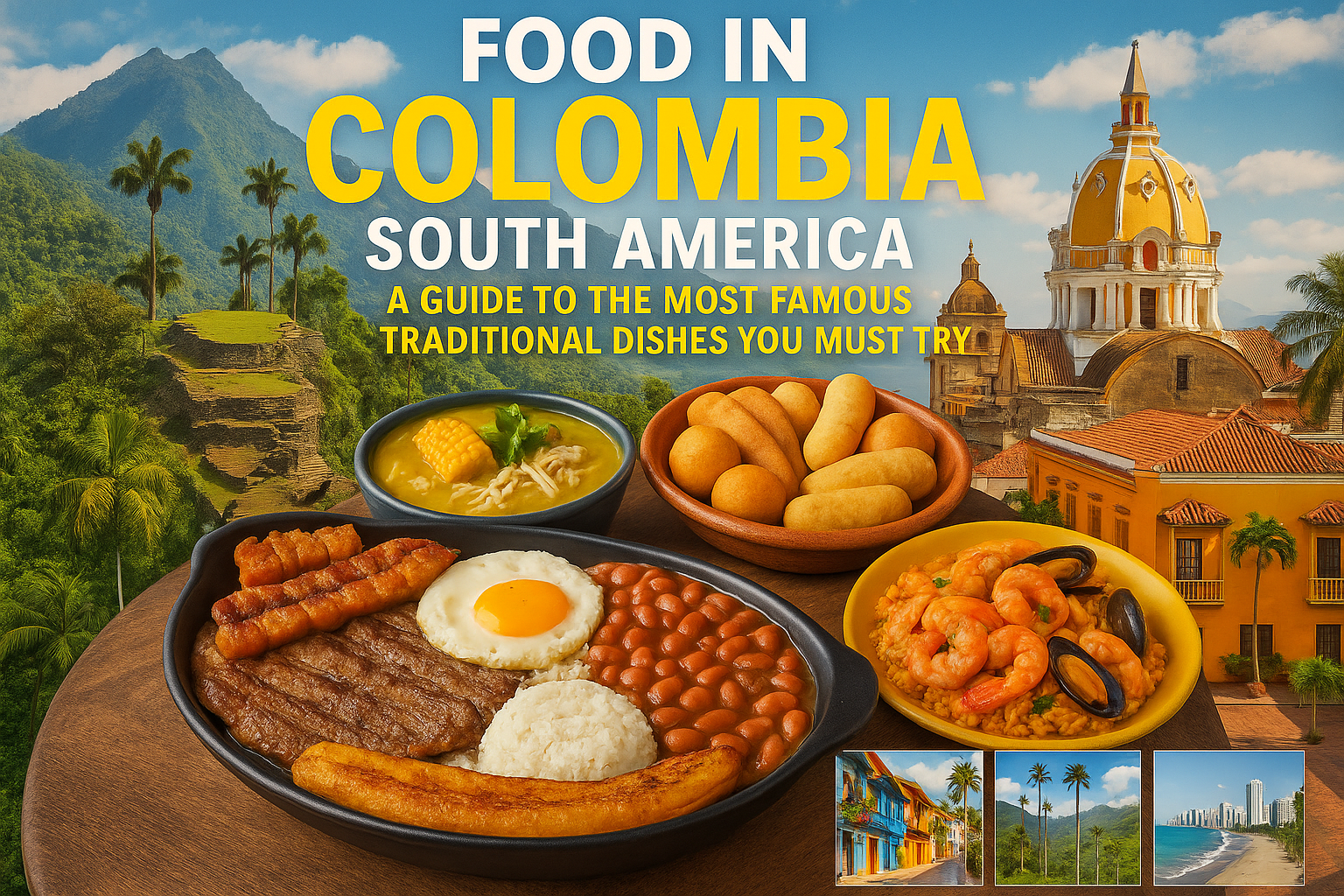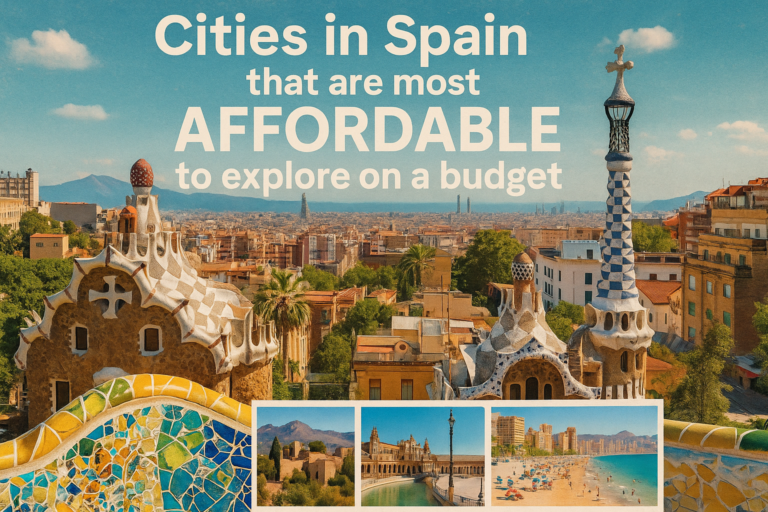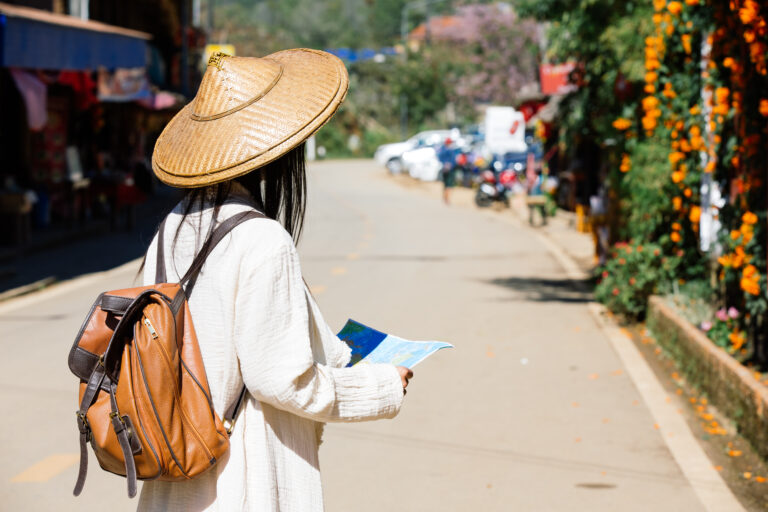Colombia’s food scene is a vibrant, mouth-watering tapestry reflecting its diverse regions and rich cultural history. In Colombia (South America), each region has developed unique specialties shaped by Indigenous, Spanish, African and other influences. From hearty stews to colorful street snacks and world-famous coffee, Colombian cuisine offers an unforgettable culinary adventure. In this guide we’ll explore the must-try traditional dishes – from Bandeja Paisa to Ajiaco, arepas, empanadas, sancocho and more – along with eating tips, history, and fun facts to help travelers savor the best of Colombia’s food culture.
A hearty Bandeja Paisa platter is emblematic of traditional food in Colombia. Colombian cuisine is as diverse as its landscape, blending mountain-grown potatoes, tropical fruits, rich meats and seafood into dishes with deep local roots. Each region – from the Andean highlands to the Caribbean coast and Amazon jungles – has signature flavors. Farmers in the Coffee Triangle grow beans for both coffee and protein-rich dishes, coastal communities favor fresh seafood and coconut milk, while indigenous heritage is visible in corn, potato and yucca staples.
Colombians cook with pride and tradition, serving food that is usually mild and comforting. Unlike Mexico or Peru, dishes are generally not very spicy by themselves – heat is often added at the table with a cilantro-based hot sauce called ají. Classic Colombian meals tend to be hearty, starch-heavy and packed with flavor. Most are best enjoyed with rice, fried plantains (patacones), and an arepa (corn patty) on the side.
Food in Colombia South America: A Guide to the Most Famous Traditional Dishes You Must Try
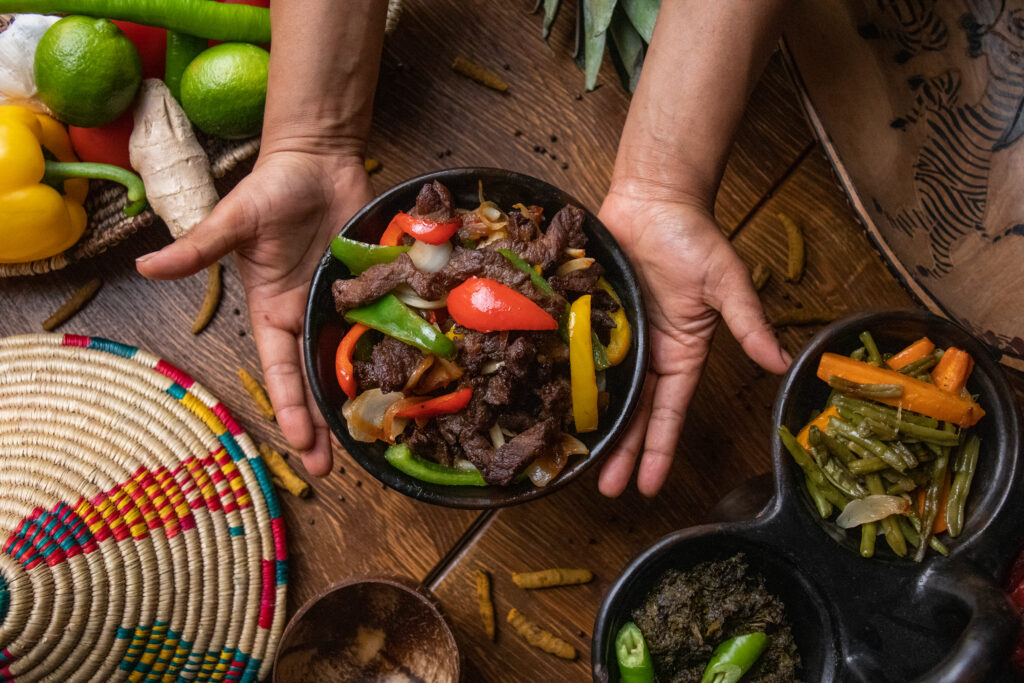
Colombian food reflects the nation’s history of cultural fusion. Indigenous peoples cultivated corn, potatoes, cassava (yuca) and local herbs long before the Spanish arrival. When the Spanish colonizers came in the 1500s, they introduced rice, beef, pork, citrus, spices and cooking techniques like stewing. African slaves brought to Colombia’s Caribbean and Pacific coasts contributed new flavors – such as coconut stews and fried fritters – while Middle Eastern immigrants introduced foods like kibbeh and certain spices. As a result, Colombian cuisine is a melting pot: a stew of Andean potatoes, Caribbean coconuts, African-style fritters and Spanish cheeses all in one.
Today, Colombian cuisine is celebrated as a key part of its heritage. In fact, UNESCO has recognized Pacific coastal cooking (in Tumaco, Nariño and Sucre) as part of Colombia’s Intangible Cultural Heritage, honoring the Afro-Colombian communities’ ancestral recipes. Meanwhile, the country’s varied topography – from high mountains to tropical plains – means local ingredients define dishes. For example, in the cool Bogotá mountains one finds warming potato soup (ajiaco) and coffee, while on the coast there’s encocado (coconut seafood stew) and mote de queso (a yam-cheese soup).
- Six Regions, Six Flavors: Colombia has six geographic regions (Andean, Caribbean, Pacific, Amazon, Orinoquía, Insular) each with signature foods. This diversity means there’s no single “Colombian food” but many local traditions.
- Indigenous Staples: Corn (maize), potatoes, cassava, beans and tropical fruits like plantains and lulo are staples, often made into arepas, tamales or stews.
- Spanish Influence: Introduced cattle (beef, dairy), pork, rice, olives and a love of stews and breads. Dishes like sancocho and ajiaco were inspired by Spanish soups (cocidos).
- African Influence: In coastal regions, frying, coconut milk and plantain-based dishes thrive. Many fried snacks (empanadas, patacones, abborrajados) and seasonings come from African traditions.
In summary, Colombian cuisine is an exciting mix – think Spanish stews and meats adapted with local tubers and fruits, African-styled spice, and the fresh, mild flavor profiles favored by Colombians.
Must-Try Traditional Dishes
No trip to Colombia is complete without tasting its classic dishes. Here are the most famous Colombian foods that travelers rave about:
Bandeja Paisa: Colombia’s Iconic Platter
Often called the jewel in the crown of Colombian cuisine, Bandeja Paisa is a festival of ingredients on one plate. Originating in Antioquia (Medellín’s region), it’s considered by many Colombians to be the national dish. A typical Bandeja Paisa includes:
- Grilled steak or ground meat, chorizo sausage, and morcilla (blood sausage) for protein.
- Rice and red beans as hearty staples.
- A crisp slice of chicharrón (fried pork belly).
- Fried egg and plantains for color and texture.
- Avocado slices for creaminess.
- Often a small arepa on the side.
Jacada Travel describes it as “a platter piled high with beef, pork, chicharrón, morcilla, sausage, rice, red beans, plantains, avocado, fried egg and more”. ProColombia notes it’s “basically a selection of local flavors, a taste of Colombia on a plate”. In other words, Bandeja Paisa is a meal itself, so bring a big appetite!
Ajiaco: Bogotá’s Hearty Chicken-Potato Soup
In Bogotá and the surrounding Cundinamarca region, Ajiaco reigns as a beloved comfort food. This creamy soup combines three types of native potatoes (yellow papas criollas, white sabana, and others) with chicken, corn kernels, and the aromatic herb guasca. The potatoes melt to thicken the soup, and the guasca herb gives it a unique, earthy flavor. Traditionally it’s served with caps of heavy cream, capers, and avocado slices on the side. On a cold Bogotá morning, a bowl of piping hot Ajiaco (often accompanied by rice on the side) is the perfect warm-up.
Sancocho: The Soulful Stew of the Country
Sancocho is a popular soup or stew found all over Colombia, with many local variations. It’s basically a hearty stock filled with large chunks of meat (usually chicken, fish or beef), yuca (cassava), corn on the cob, and plantains. Some versions add potatoes or carrots. Each region has its spin (e.g. Sancocho Valluno from Cali with multiple meats), but all share the comforting broth and mix of starches. Sancocho is often served with rice, avocado and ají sauce on the side. Colombians consider it the ultimate comfort food or hangover cure – it’s filling, rustic, and deeply satisfying.
Tamales: Wrapped Goodness
Colombia’s tamales are banana-leaf wrapped bundles of deliciousness. Each region makes them differently, but typically they contain corn dough filled with meats (pork or chicken), rice, peas, carrots, potatoes and seasonings, all steamed in a banana leaf. For example, Tamales Tolimenses from Tolima (Andean region) are famous: they’re chunky pockets stuffed with pork, rice, veggies and spices, boiled for hours. Tamales are a traditional special-occasion dish, often eaten at Christmas or family gatherings, and make a hearty breakfast or lunch.
Fritanga: A Carnivore’s Feast
If you’re a meat-lover, try fritanga – a shared platter of assorted fried and grilled meats. This is Colombia’s answer to a “meat feast”: think various cuts of pork, beef, sausages, blood sausage (morcilla), chorizo, chicharrones, plus chicken or offal like tripe. It’s typically served family-style with toothpicks for picking meat bits. Jacada Travel highlights fritanga alongside Bandeja Paisa and Lechona as must-try hearty dishes. It’s often enjoyed with a cold beer – a very true Colombian experience. (Not for vegetarians, but it’s one way to say “I ate all the meats!”.)
Patacones and Aborrajados: Banana Favorites
Colombia loves plantains! One beloved snack is patacones (tostones): green plantains are sliced, smashed flat and fried until crisp. These savory fritters are served plain with salt, or topped with beans, meat, cheese or hogao sauce (tomato-onion salsa). Another treat is aborrajados: ripe sweet plantains fried with cheese (and sometimes guava jam) sandwiched inside. Street vendors and restaurants serve these as appetizers or sides – salty, sweet, and utterly delicious.
Arepas: Colombia’s Corn Cakes
Perhaps the most iconic Colombian staple is the arepa: a grilled or fried cornmeal cake often eaten at all hours. Every family has its arepa tradition – some plain, some stuffed with cheese or egg – and you’ll find them in homes and street stalls alike. Arepas can be a side dish at lunch or dinner, or a filling breakfast. They may be split open and filled with cheese, shredded meat, avocados or just butter and cheese. Jacada Travel notes: “Arepas can be stuffed with cheese and egg or topped with avocado, beans, meat or pretty much anything else… They can be sweet or savory.”.
Arepas are a ubiquitous Colombian staple. They can be plain (patacones), cheese-filled, or topped with beans, and are eaten as snacks, sides or breakfasts.
Empanadas: Crunchy Corn Pockets
Colombian empanadas are deep-fried turnovers made from corn dough, a twist on the more global stuffed pastry. Unlike Argentine baked empanadas, Colombian ones are crisp and golden. Popular fillings include ground beef or chicken mixed with potato (the classic) and sometimes pork, egg or vegetarian options. They are typically enjoyed warm, with a squeeze of lime and a dollop of ají salsa on the side. Bite into one and the crunchy exterior gives way to savory meat and potato inside. They’re found in every market, street vendor, and even as frozen snacks in Colombian supermarkets!
Lechona: Festive Stuffed Pork
Lechona is Colombia’s answer to a festive roast – a whole pig stuffed with rice, peas and spices, then slow-roasted until the skin is crispy. This dish, originally from Tolima, is served on special occasions like weddings and holidays. Imagine tender pork meat mixed with savory rice inside a crackling shell – that’s Lechona. It’s rich and flavorful; usually eaten family-style and best shared (with plenty of napkins on hand!). ProColombia describes it as “luscious pork roast filled with rice, onion and vegetables… slow cooked with spectacular crackling”.
Coastal Seafood: Cazuela and More
On Colombia’s Caribbean and Pacific coasts, seafood shines. Try cazuela de mariscos (a creamy coconut milk and seafood stew with shrimp, fish, mussels), ceviche made with Colombian citrus, or simply a whole grilled or fried fish (snapper or mojarra are popular) served with coconut rice. The coastal cuisine also incorporates Afro-Colombian influences: for example, encocado is a coconut-based seafood sauce from the Pacific, and mote de queso (from Cartagena area) is a chowder of yam and queso costeño cheese. If you find yourself near Cartagena or Barranquilla, look for pescaíto frito (fried whole fish) on the menu – often simply fried until golden and eaten with lime.
Street Food and Snacks
Colombia has a vibrant street food culture. Markets and vendor carts offer tasty bites that are perfect for grazing:
- Arepa Rellena: A variation of the classic arepa, often split open and stuffed with cheese, shredded chicken or beef, and a fried egg. It’s portable and filling.
- Patacones: As mentioned, twice-fried plantain slices, sometimes served with beans, cheese or hogao.
- Aborrajados: Sweet plantains filled with cheese and deep-fried, sometimes drizzled with jam or honey.
- Pandebonos and Almojábanas: Colombian cheese breads. Pandebono is a chewy cornmeal and cheese bread; almojábana is a soft baked roll with cheese. Both are best enjoyed warm.
- Empanadas: Deep-fried corn turnovers filled with meat or potato, often enjoyed with spicy ají salsa.
- Buñuelos: Fried cheese fritters (small dough balls) – crispy outside and soft, cheesy inside. These are especially popular around Christmas.
- Obleas: Thin wafer-like cookies sandwiched with arequipe (dulce de leche). Sweet and crunchy.
- Carimañolas: (Eastern Colombia) yuca dumplings stuffed with meat or cheese and fried.
Jacada Travel sums up street food: “the most iconic Colombian treats can be purchased from street vendors… First and foremost, there’s the famous arepa… Another common snack… are patacones… Next up there’s… empanada… A common accompaniment for any of the snacks is hogao.”. In other words, while wandering a market or city, anything deep-fried and corn-based is worth a try!
Beverages and Desserts
Colombia also has wonderful drinks and sweets:
- Coffee: Colombia is world-famous for coffee. In any cafe you’ll find tinto (black coffee) or café con leche. The Coffee Triangle region even offers tours of coffee plantations. Trying a cup of freshly brewed Colombian coffee is a must.
- Aguardiente: The national spirit, flavored with anise, often drunk at celebrations.
- Agua de Panela: A sweet, hot drink made by dissolving panela (unrefined cane sugar) in water, often served with cheese or bread.
- Fruit Juices: With Colombia’s bounty of tropical fruits, fresh juices are everywhere. Try lulo, granadilla, guanábana, maracuyá (passion fruit), or champús (a mix of corn, pineapple and panela).
- Hot Chocolate with Cheese: In the mountains, Colombians sometimes add cheese cubes to hot chocolate – sound strange, but it’s a cozy treat.
- Desserts: Beyond candying fruits, Colombians enjoy natilla (a custard) and buñuelos at Christmas. The “fruit candies” mentioned by ProColombia are dulce de fruta – thick preserves of guava, papaya or other tropical fruits – a tangy sweet snack.
Tip: Be ready to taste fruits you’ve never heard of – local markets boast native fruits like zapote, lulo, curuba and feijoa. Juice stands (juguerías) often let you mix and match.
Regional Specialties
- Bogotá/Andes: Ajiaco (potato-chicken soup), Changua (a milk-and-egg soup for breakfast), and hearty stews like Mondongo (tripe stew).
- Medellín (Antioquia): Bandeja Paisa, Bistec a Caballo (steak with tomato-onion sauce topped with egg), and tamal antioqueño.
- Caribbean Coast: Seafood specials, encocado (coconut seafood stew), arroz con coco (coconut rice), and fresh fruit drinks. The region also has frituras (fried snacks like empanadas and carimañolas).
- Valle del Cauca (Cali): Known for sancocho valluno (one-meat sancocho), lulada (a local lulo smoothie), and lunches with churrasco (steak).
- Bucaramanga/Santander: Mute santandereano (a bean, corn, pork stew), hormigas culonas (edible ants – a local delicacy!), and exotic river fish dishes.
- Amazonas: Novel ingredients like paiche fish or camu camu fruit, often in simple preparations.
Each city, from Cartagena to Cali to Bogotá, has its own food identity. Seek out local specialties and markets – you’ll find everything from humble street stalls to gourmet takes on tradition.
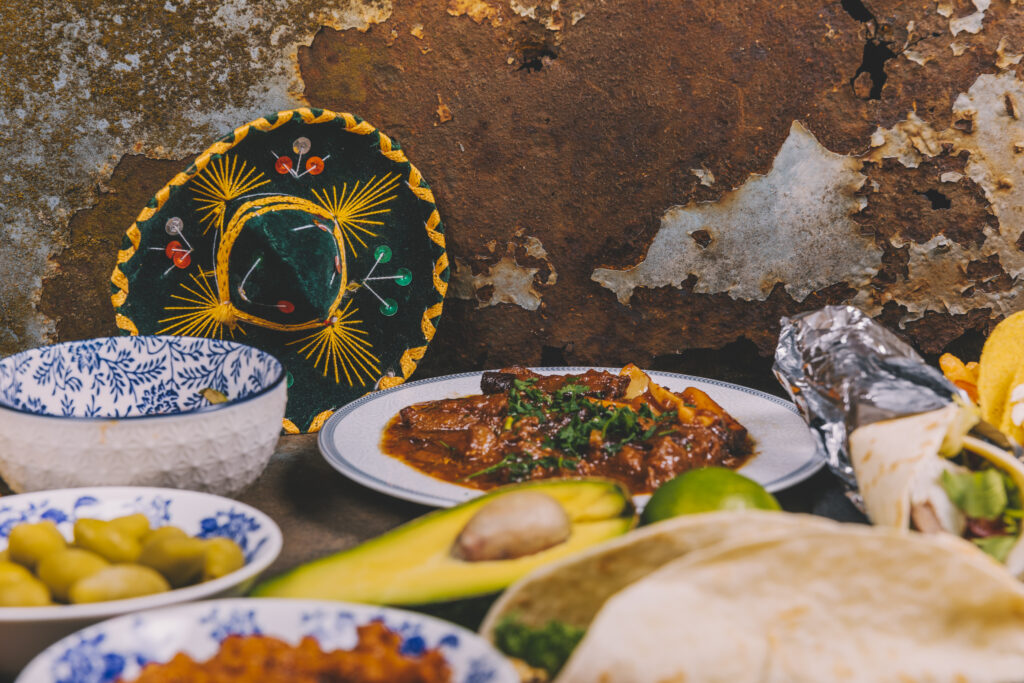
Eating Like a Local: Tips and Experiences
- Meal Structure: Colombians typically have three main meals. A hearty almuerzo (lunch) is the biggest, often with soup or salad first, followed by an entrée with rice/beans/plantain. Dinner is lighter. Breakfast might be eggs with arepas and hot chocolate.
- Coffee Culture: Expect to be offered a free cup of coffee (“café Tinto”) at shops or even some businesses – Colombians are famously hospitable with their coffee.
- Dining Out: Piqueteaderos are rustic eateries where you share platters of meats and sides family-style. They’re great for trying many things.
- Markets and Street Stalls: Visit a local mercado (like Paloquemao in Bogotá) to taste juices, cheese, arepas and fruits. Street food carts (e.g. in Medellín’s Old Quarter or Cartagena’s plazas) will offer empanadas, buñuelos, and fruits on skewers.
- Use of Ají: You’ll often find small bowls of homemade ají (chili-cilantro salsa) on tables. Add a spoonful to your food if you like heat – it’s how Colombians spice up dishes without cooking them hot.
- Vegetarian/Vegan: Traditional Colombian fare is meat-heavy, but vegetarians can enjoy many staples like patacones, empanadas (without meat), arroz con coco (coconut rice), fresh juices, fruits, and cheese breads. Just ask for “sin carne” if needed. Vegan travelers should note many soups use chicken broth or dairy, but ajiaco (hold the cream) or cocadas (coconut sweets) can be friendly options.
Fun Facts and Tips
- National Dish? Colombians often nominate Bandeja Paisa or Ajiaco as their national dish, but really it depends on who you ask.
- Not Like Mexican Food: Colombians don’t generally use chili peppers in cooking. Most dishes are mild or savory. Tacos and spicy salsas are not common here!
- Food Celebrations: During Christmas, families bake buñuelos, natilla (sweet custard), and hojuelas (fried flour crisps). Don’t be surprised if you see these treats in December.
- Street Snack Heaven: If you hear a street vendor shouting “¡Empanadas a mil!” it means empanadas for 1,000 pesos (about 25 cents) – an irresistible deal in Colombia.
FAQs (Frequently Asked Questions)
- What are the most famous Colombian dishes?
Bandeja Paisa (bean-rice platter with meat and plantains) and Ajiaco (chicken-potato soup) are the top two. Other must-tries include sancocho (stew), empanadas, arepas, patacones, lechona, tamales, bandeja paisa, and buñuelos. Each region has its specialties, but these appear on menus nationwide. - Is Colombian food spicy?
No, traditional Colombian dishes are generally mild and not spicy. Spices like hot chili peppers are not typically cooked into meals. Instead, diners spice food themselves at the table using ají sauce (a fresh chopped chili and cilantro salsa). Think of Colombian food as flavorful but not fiery by default. - What do Colombians eat for breakfast?
A common breakfast might be arepas with cheese or eggs, hot chocolate with cheese, or calentado (a reheated mix of rice and beans from last night, served with a fried egg). In Bogotá, a traditional breakfast is changua (a milky cilantro soup with egg and cheese). Coffee or hot milk is usually included. - Are there vegetarian options?
While many staples feature meat or chicken, vegetarians can enjoy arepas, patacones (plain fried plantains), empanadas (filled with potatoes or cheese), locro de papas (potato soup), guacamole/ají, and a wide variety of tropical fruits and juices. Since beans and rice are common, vegetarians can often fill up on sides and snacks. - What should I drink?
Try Colombian coffee (smooth and aromatic). Non-alcoholic traditional drinks include aguapanela (sweet cane water), lulo juice, maracuyá (passion fruit) juice, champús and salpicón (fruit cocktails). If you drink alcohol, aguardiente (an anise-flavored liquor) is the national tipple, and local beers (like Águila or Club Colombia) pair well with spicy frituras. - Where can I find good Colombian food?
Look for local eateries and street markets rather than international restaurants. Areas like Bogotá’s La Candelaria, Medellín’s Pueblito Paisa, or Cartagena’s Old Town have many traditional restaurants. Food courts in Tiendas D1 or Carulla supermarkets often have small stands selling arepas, soups and empanadas. Don’t miss a trip to a bustling mercado (market) – it’s the best way to sample authentic street food.
Final Thoughts
Colombian cuisine is an exciting exploration of flavors, colors and traditions. Whether you’re savoring the steaming soup of Ajiaco in a cool Andean village, diving into a giant Bandeja Paisa in Medellín, or sharing spicy empanadas and sweet juices at a coastal market, you’ll discover why travelers fall in love with Food in Colombia, South America. Every meal tells a story of the land – from the lush Coffee Triangle to the Caribbean shores. The next time you plan a trip, bring your appetite and an open mind: Colombia’s most famous dishes are more than food; they’re a delicious cultural journey you won’t want to miss. ¡Buen provecho!


